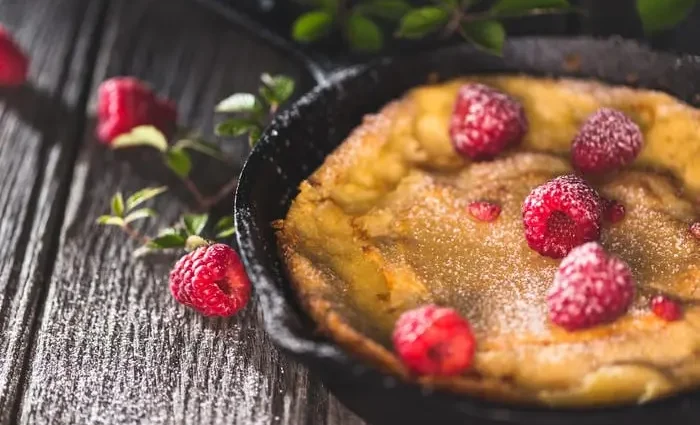Contents
Purple mokruha is a good valuable mushroom that is suitable for eating. The mushroom is not very common, but it has a lot of useful properties and is therefore of great interest.
What do purple mokruhi mushrooms look like?
Mokruha purple, also known as pine mokruha or yellowleg, belongs to the Boletov order and the Mokrukhov family, has a fairly recognizable appearance.
The photo of the purple mokruha shows that its hat is relatively small, from 4 to 8 cm in diameter, at a young age it is round, convex and with a characteristic blunt tubercle in the middle, and in an adult it is prostrate or even concave. The surface of the cap is smooth, in wet weather it becomes covered with a mucous coating, the color is very unusual, brownish-lilac or with a reddish wine tint. From below, the surface of the cap is covered with wide thin plates, in young mushrooms they are pinkish-purple, and in adults they are dirty brown, sometimes almost black.
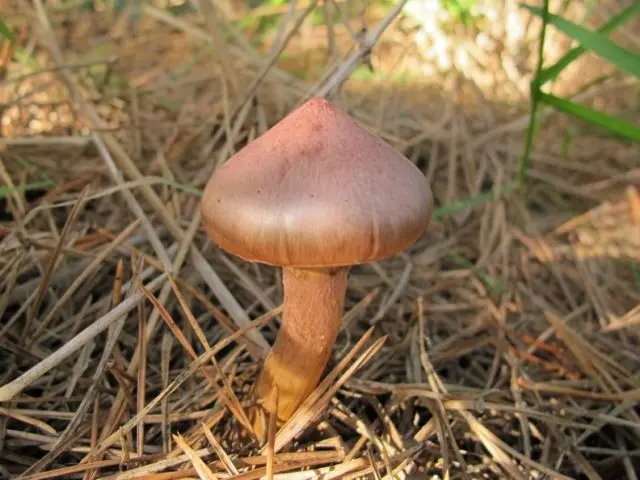
The leg of the purple mokruha is thin, rises up to 10 cm above the ground, is often curved and usually tapers slightly towards the base. The color of the leg has the same shade as the hat, but remains a little lighter. The structure of the leg is silky to the touch, often you can see the remains of a bedspread on it, especially in young fruiting bodies.
If you cut the purple mokruha, then the flesh of the cap will be dense and mauve, with a neutral smell and taste. The leg on the cut is lilac-red, and at the very base it is yellow.
Where do pine mosquitoes grow
Purple Mokruha is not the most common mushroom in Our Country. However, you can see it on the territory of almost the entire country – in the middle lane, in the Caucasus and in the Crimea, even in Siberia. Most often, yellowleg grows on calcareous soils in coniferous and mixed forests. It is sometimes found in the hills, but usually forms a symbiosis with birches or pines.
Purple Moruha grows both singly and in groups. Often she comes across near the oil, because she chooses similar habitats.
Is it possible to eat mokruhi pine mushrooms
Purple mokruha is classified as an edible mushroom. Fruiting bodies must be processed before cooking, but then the pulp can be used in almost any recipe.

Taste qualities of the mushroom purple mokruha
According to taste characteristics, purple mokruha belongs to only category 4. This means that you can eat it, but the yellowleg will not please you with a rich and original taste. Many mushroom pickers compare the taste of purple mushrooms with the taste of butter. Often edible yellowleg is used in combination with other mushrooms, a mixed assortment has a more pleasant taste.
Benefits and harm to the body
The popularity of purple mokruha in cooking is due not only to its taste. Yellowleg is able to bring great health benefits, because it has a valuable chemical composition. Its pulp contains the following substances:
- vitamins B2, B1 and E;
- ascorbic acid;
- vitamin PP;
- cellulose;
- a large amount of high-quality vegetable protein;
- amino acids;
- organic acids and enzymes;
- potassium and iron;
- calcium, phosphorus and manganese.
With good nutrition, the yellowleg is very low in calories and contains only 19 kcal per 100 g of pulp, therefore it is found in many diets.
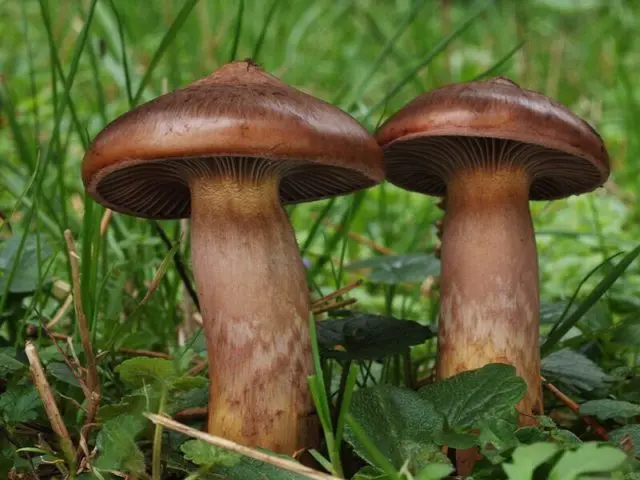
The use of purple mokruha has a beneficial effect on the body, because the product:
- strengthens the immune system and improves the functioning of the metabolic system;
- helps relieve inflammation and fight infections;
- has a calming and relaxing effect;
- positively affects the muscular system;
- promotes cell renewal;
- improves the condition of the skin and hair;
- it has a good effect on blood vessels and protects the heart from the development of chronic ailments;
- strengthens memory and improves brain function.
Despite its many beneficial properties, purple mokruha has some contraindications. First of all, it is not recommended for pregnant women and nursing mothers to eat it. You should not offer yellowleg to young children under 7 years old, any mushroom pulp is poorly absorbed by their body due to its high protein content.
False doubles
Purple mokruha does not have poisonous and health-threatening twins. But in the absence of experience, it is quite possible to confuse it with edible mushrooms of the same species.
spruce mokruha
This mushroom is very similar to the purple variety in structure. His hat is also medium in size, first convex and then prostrate, the leg reaches 12 cm in height and 2,5 cm in girth. But you can distinguish a spruce mushroom by a shade of color, its hat is gray or gray-violet, it does not have an unusual wine hue.
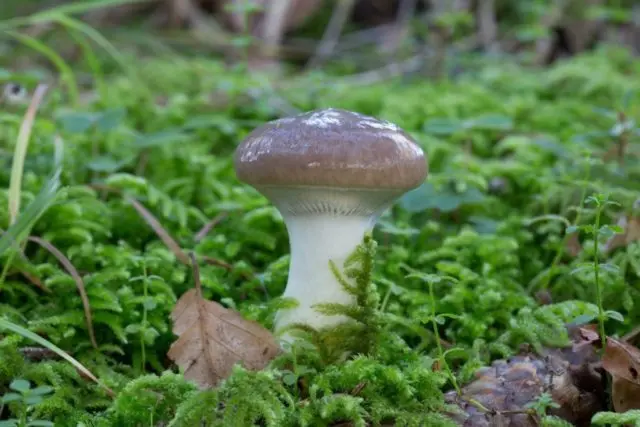
Spruce mokruha grows in accordance with its name mainly in spruce forests and forms a symbiosis with spruce trees. You can eat it, but its taste is rather average.
pink wet
Another variety similar to the photo of pine mokruha is pink mokruha. Mushrooms are united by similar features in the structure – strong cylindrical legs, narrowed at the bottom, and convex at first, and later prostrate caps. But the differences between the varieties are noticeable – the pink mokruha is much smaller and rarely exceeds 5 cm in diameter. In addition, her hat is bright pink at a young age, in old fruiting bodies – with a slight yellowish tint and dark brown spots.
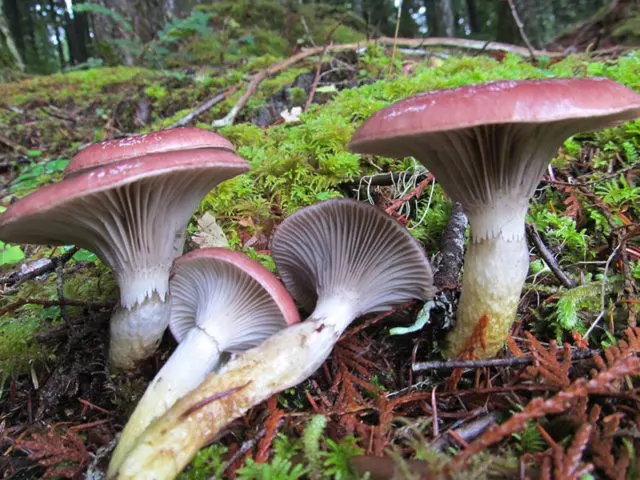
Pink mokruhi grow in coniferous forests, mainly in the mountains, and are often found next to goats. The fungus is not widely distributed and is quite rare. Like the purple mokruha, it is in the edible category, but has a mediocre taste and needs to be peeled before consumption.
Collection rules
You need to go to the forest for purple wetlands during the period of maximum fruiting, from August to the end of September. It is best to choose days after prolonged rains; in wet weather, fruiting bodies grow especially quickly and massively.
You need to collect purple mokruhi in clean places located at a distance from cities, industrial facilities, railways and highways. Since the mushroom pulp absorbs all the toxic substances from the earth and air, yellowlegs collected in ecologically unfavorable areas will not be able to benefit health.
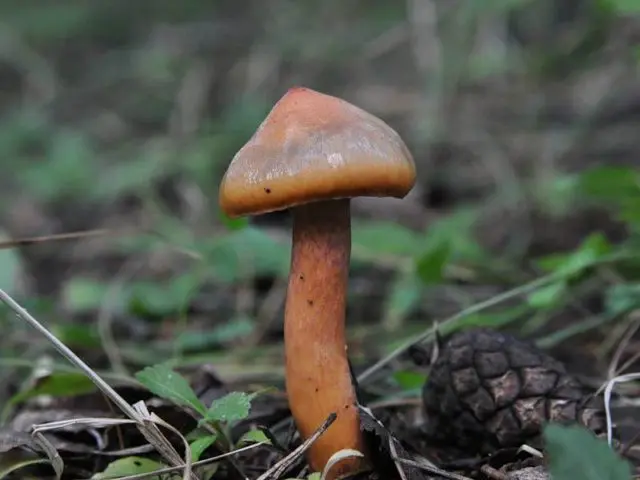
Purple Mokruh Recipes
Purple mokruha is suitable for almost any cooking method. But before frying, marinating or otherwise preparing purple mokruha, does it need to be pre-processed?
- It is necessary to prepare fresh fruiting bodies within a day after collection, they are not stored for a long time and quickly begin to deteriorate.
- Before cooking, it is mandatory to remove the mucous film on the cap from the yellow leg, and then rinse it in cold water.
Boiled mokruhi
The quickest way to cook autumn yellowleg is to simply boil it in salted water. Peeled and washed hats and legs are put on the stove and boiled for only 15 minutes. After that, the water is drained, and after cooling, the mushrooms are added to the salad, consumed as a snack, or subjected to further processing.
Fried mokruhi
Yellow legs fried with potatoes, meat or vegetables can please with a pleasant taste. Boiled hats and legs are laid out in a frying pan greased with vegetable oil and fried together with onions or chopped potatoes for as long as necessary until the side dish is ready. At the same time, it is not necessary to check the yellow legs themselves; they do not require long frying using a special technology.
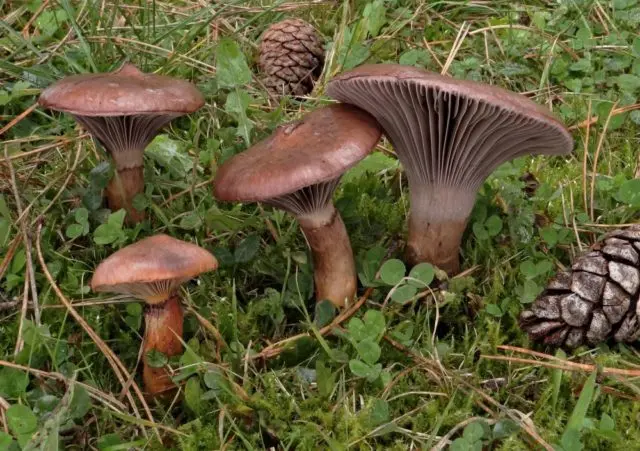
Salty mokruhi
The classic cooking method is cold pickling of purple mokruha, which allows you to save mushrooms for the winter. The recipe looks very simple – pre-boiled hats and legs are laid in layers in a sterile glass jar. Sprinkle each layer with plenty of salt, and you can also add spices to the salting, for example, dill seeds and peppers, garlic and cloves.
The filled jar is covered with folded gauze along the neck and pressed down with oppression. After a few days, the mushrooms should completely cover the secreted juice, and after another 40 days, the pickles are ready to eat. In the process of salting, the gauze on the neck of the jar needs to be changed from time to time so that mold does not start on it.
Conclusion
Purple Mokruha is a versatile edible mushroom that can be processed in any way. The taste of the yellowleg is not considered a delicacy, however, in a mushroom platter or in combination with other products, it is quite pleasant, and it also benefits the body.










